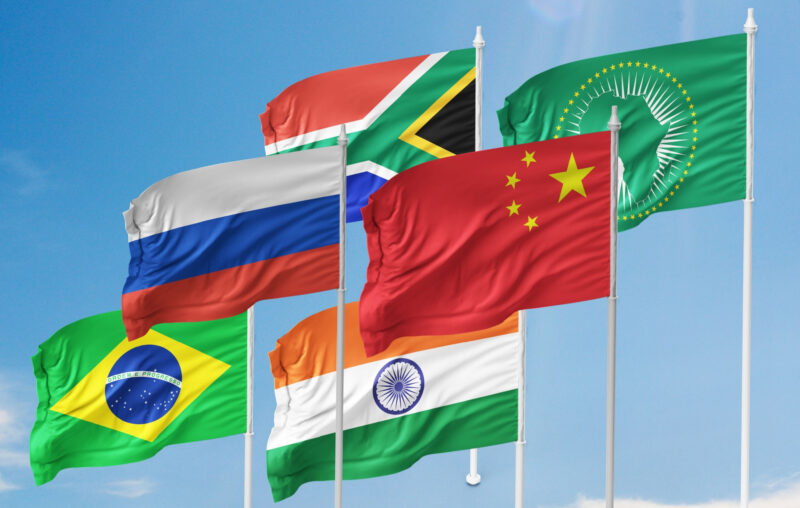The Rise of BRICS-11

The 15th BRICS Summit ended on August 24th, as expected, with new member states. The core members (Brazil, Russia, India, China, and South Africa) were joined by Saudi Arabia, United Arab Emirates, Iran, Egypt, Ethiopia, and Argentina. While there are many commonalities among the now 11-member BRICS bloc, two general observations can be made. First, that the economic center of gravity of the expanded group will be commodities: world energy markets, primarily. And, that the political backbone of BRICS is now primarily authoritarian.
Freedom House scores only three of the eleven (Argentina, Brazil, and South Africa) as “free” in its Global Freedom Score Index. The Heritage Foundation’s 2023 Index of Economic Freedom rankings are more damnatory, with ten of the eleven countries ranked as “mostly unfree” or “repressive.” United Arab Emirates is the sole exception, landing in the “mostly free” category at #24 in the world. (Bracketing it at #23 is Chile, and at #25, you guessed it: the United States of America.)
Some of the preexisting links between new and original BRICS members are obvious. Iran has developed close relationships with both China and Russia over the past decade or so. Ethiopia, despite a ruinous civil war, has increasingly been viewed as a nation of potentially strategic importance for several years. (Food aid to the nation was cut off several months ago following accusations that it was finding its way to military units as opposed to civilians.)
The official consecration of BRICS-11 will take place on 1 January 2024. Certain nations will likely capitalize on inter-bloc synergies and work together immediately, though it would be naive not to take note of some of the potential fault lines in the order. Saudi Arabia and Iran have been bitter rivals for decades, although in March of 2023 China brokered a peace deal between them. Similarly, Egypt and Ethiopia’s tussling over access to the Nile River has put them at odds, but may be resolved by the end of 2023. (Egypt also, as a brand new member of BRICS, recently found itself on the receiving end (although distantly) of original BRICS member Russia’s military activity on the Danube River.) And China’s Xi and India’s Modi agreed at the end of the summit to seek the expeditious resolution of border disputes which have intermittently resulted in combat since the Sino-Indian War in 1962.
The combined global GDP of the original five BRICS members accounted for approximately 42 percent of global GDP. With the new members, that number will rise to roughly 50 percent. (The G-7 nations, meanwhile, represent somewhere between 27 and 31 percent of global GDP.) But that statistic, like most economic statistics, is grossly misrepresentative without context. Argentina is currently in a hyperinflationary spiral, Ethiopia’s debt is in desperate need of restructuring, the ruble is withering away to levels not seen since the initial invasion of Ukraine, and China’s real estate sector is in freefall with several major firms facing Lehman-like collapses. Economic instability currently vexes about half of the BRICS-11 members, and for many has been more or less their default condition for decades. The explicit BRICS goals, which include expanding the reach of the New Development Bank (NDB), closer trade cooperation, and a dollar-alternative currency are undoubtedly viewed as a means to alleviate the perennial woes of economic mismanagement. And, of course, to slip Western spheres of influence.
About dedollarization, the most anticipated aspect of this year’s summit, there were only conflicting messages and ultimately a deferment. Several days before the meeting began, announcements claimed that the NDB would make loans denominated in South African Rand and the Brazilian Real. Brazil’s Lula de Silva’s opening comments, in fact, included the staunch rhetorical “Who decided the dollar would be the [world’s] currency?” Yet at the end of the summit South African Minister of Finance Enoch Godongwana commented that “[n]o one … tabled the issue of a BRICS currency, not even in informal meetings.” He then added: “Setting up a common currency presupposes setting up a central bank, and that presupposes losing independence on monetary policy, and I don’t think any country is ready for that.” As commented previously, creating an accord of nations
from different continents and cultures, with different histories and remarkably diverse resource endowments will be a heavy lift, organizationally speaking. Smaller members are likely to find their interests marginalized, with the resulting dynamic closer to what’s seen in the United Nations than, say, OPEC. And few of the proposed members have confidence-inspiring track records where property rights are concerned.
Departing BRICS-11 finance ministers were tasked with reconvening at the 16th BRICS Summit in 2024, having by that time explored “issues of local currencies, payment instruments, and platforms.” To some onlookers (and indeed, some participants) it was an undoubtedly anticlimactic end. Yet it clearly reflects both tensions arising of different levels of dollar dependence and the realization of the difficulty underscoring extricating the dollar from its global economic moorings. King Dollar is far from invulnerable, but the height of his throne is ritually underestimated.









